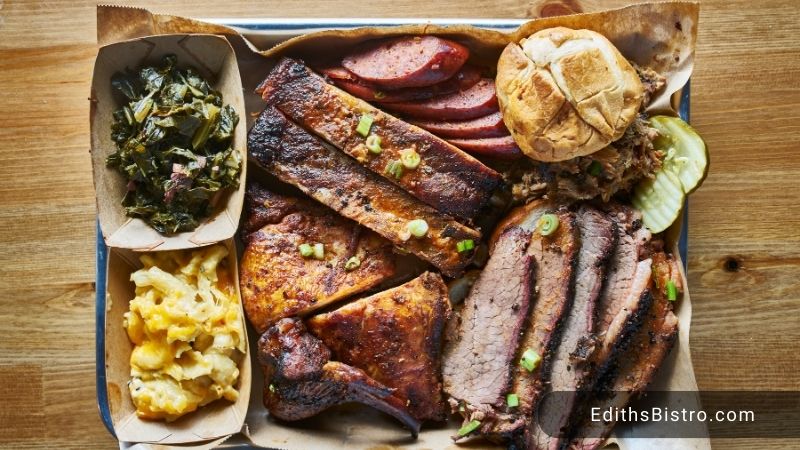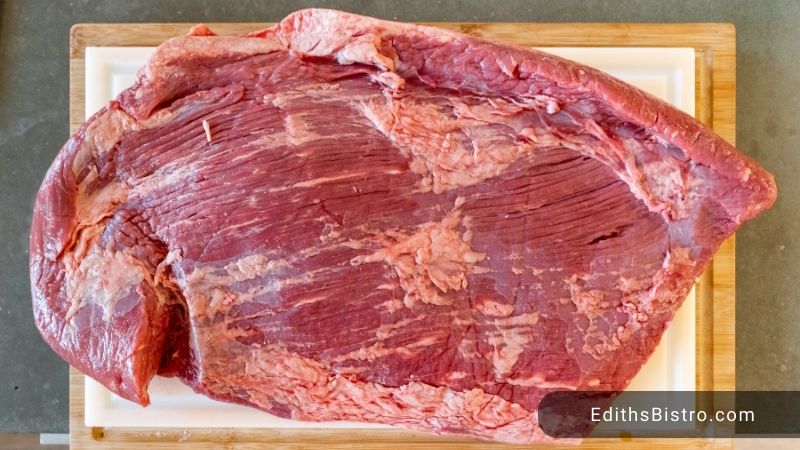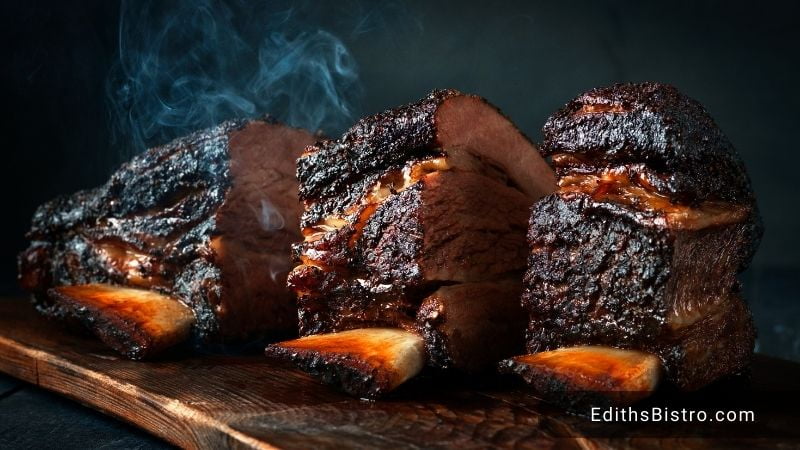Brisket is a barbecue staple, but its meat origin can cause confusion. So is Brisket beef or pok? This article explores brisket’s origins and best cooking methods.
Is Brisket Beef Or Pork?
Brisket can sometimes be confused—is it beef or pork? The short answer is that traditionally, brisket comes from beef. Yet, as BBQ becomes a culture, brisket can now also be pork.

Regardless, brisket is relatively tough and contains a lot of connective tissue, which is why it is best cooked slowly over low heat.
Is Beef Or Pork Brisket Better?
When it comes to taste and texture, both beef brisket and pork brisket have their merits if cooked properly. Let’s go over some of the main differences:
Beef brisket:
- Larger in size, typically 10-14 lbs for a whole brisket
- More uniform fat distribution
- Widely recognized as the classic barbecue brisket
- The deep, beefy flavor
Pork brisket:
- Smaller than beef, about 1-4 lbs
- Higher concentration of fat near the shoulder
- Slightly sweeter taste due to higher fat content
- Similar structure to beef brisket with lean and fatty areas
For barbecue traditionalists, beef brisket is superior due to its fat content, size, and traditional preparation. But pork brisket can also be incredibly moist and flavorful. So whether you prefer the tenderness of pork or the classic beefiness of brisket, it comes down to personal taste. Try them both to decide which you like better!
Is Smoked Brisket Beef Or Pork?
While beef and pork brisket can be smoked, smoked brisket is traditionally and most commonly associated with beef brisket. Brisket’s high-fat content and the low, slow smoking process at temperatures around 225°F results in incredibly tender and flavorful meat.
So, if you see smoked brisket on a menu or at a barbecue competition, you can assume it is made from beef. That said, pork brisket can also be delicious when smoked and makes a nice change of pace from the typical beef. Just don’t expect as much fat or quite the same level of tenderness as properly smoked beef brisket.
Is Chili’s Brisket Beef Or Pork?
Based on online reviews and recipes, it seems likely that the brisket served at Chili’s restaurants is made from beef. The Chili’s website shows their brisket dishes accompanied by descriptions like “hickory smoked for hours”. Their Smokehouse Brisket Sandwich is pictured as a typical beef-style barbecue brisket.
However, some customers say the flavor and texture leave something to be desired compared to true smoked beef brisket from barbecue restaurants.
What Is Traditional Brisket?
A brisket is a cut of meat from a cow’s breast or lower chest. It’s considered one of the nine beef primal cuts. Brisket contains a lot of connective tissue, so it requires long, slow cooking methods like smoking or braising to break down the tough fibers into a tender, juicy result.

A full brisket is a large, rectangular cut weighing 10–14 pounds. It consists of two separate muscles:
- The “flat” or “first cut” is the leaner, thinner half of the brisket closer to the cow’s bones. It’s also called the deep pectoral muscle.
- The “point” or “second cut” is the fattier, thicker half of the brisket located further from the bones. It’s also called the superficial pectoral.
What Is Pork Brisket?
While beef brisket is more common, pork brisket comes from a pig’s equivalent pectoral muscle region. It’s typically sold connected to the pork shoulder as part of a larger cut known as a “picnic ham.”
Pork brisket is smaller and thinner than beef brisket, weighing 1-4 pounds. It contains a higher fat ratio since pigs are naturally fattier than cows. Due to its marbling, pork brisket can have a richer, sweeter flavor when cooked properly. While pork brisket isn’t as widely recognized or used as beef, it can make for a delicious and tender barbecue when smoked or braised.
How Is Pork Brisket Different From Beef Brisket?
While beef brisket may win on size, tradition, and notoriety, pork brisket makes an excellent and less expensive choice for smoking or backyard barbecue. It just requires adjustments for its smaller size and cooks faster than the beef equivalent.
- Size: Pork briskets are much smaller than beef, averaging 1-4 pounds versus 10-14 pounds for a whole beef brisket. The smaller size means pork brisket cooks faster.
- Price: Pork brisket is more affordable at around $3-4 per pound compared to $7-8 for quality beef brisket.
- Ease of Cooking: The smaller size and quick cooking time of pork brisket makes cooking a little easier. Beef brisket requires meticulous temperature and time control due to its larger size.
- Fat Content: Pork contains more fat than beef so pork brisket will be richer with a fattier mouthfeel.
- Flavor: Pork brisket has a sweeter, milder flavor than the deeper “beefiness” of a well-cooked beef brisket.
- Serving: Pork brisket serves far fewer people due to the size difference. You can expect 8-12 portions from a whole pork brisket versus up to 20 portions from a large beef brisket.
How To Buy The Best Brisket?
When purchasing brisket, whether beef or pork, let’s break down the process and have a walk-through!

Look for good marbling or intramuscular fat, which bastes the meat during cooking. But avoid excessive surface fat, which can lead to flare-ups.
Seek thicker cuts over thinner ones, ideally around 1 1⁄2 – 2 inches thick. Thinner cuts dry out faster.
For whole-packer briskets, check that the flat cut is also reasonably thick. Choose briskets with a darker color rather than pale or gray hues.
Opt for the highest quality grades like Prime or Choice rather than Select. This provides better fat content and flavor.
Compare prices to find a reasonably priced yet high-quality brisket for your budget. Briskets around $7-8/lb provide good value.
Calculate at least 1⁄2 pound of brisket per person, up to 3⁄4 – 1 pound for big eaters or if you want leftovers. An 8-10 lb packer brisket feeds 10-12 people.
What Is The Best Way To Cook Brisket?
Low and slow is the name of the game when it comes to cooking brisket! When cooking up deliciously tender brisket, I recommend slow-cooking it in a smoker or oven. For optimal results, set your smoker to 225°F and let the brisket work its magic for 1-2 hours per pound. You’ll want to cook it until the internal temperature hits 203°F. This long, low, and slow process allows the fat to render and the collagen to transform into gelatin, ensuring the meat stays incredibly moist and tender.
If using the oven, seal the brisket tightly in foil and bake it at 300°F, following the same 1-2 hours per pound rule until it hits 185-205°F internally. No matter how you cook it, let the brisket rest for 10–15 minutes before slicing it against the grain. This allows the juices to be redistributed evenly for maximum tenderness. Trust me, brisket prepared either way melts in your mouth and is heaven! The key is keeping it low and slow to get the most deliciously tender brisket.
FAQs
Are there any cultural or regional variations in brisket preferences?
Yes, different cultures and regions have varying traditions regarding brisket, with beef being more common in some areas and pork in others.
Is A Bisket Halal?
Yes, beef brisket is widely considered halal. But let’s make sure that your brisket does not come from pork. It’s always better to ask for confirmation.
Is Brisket Similar To Pork?
While both brisket and pork are used in barbecue, they have distinctly different flavors, with pork being sweeter.
References
- Brisket: https://en.wikipedia.org/wiki/Brisket
- Halal meat: https://en.wikipedia.org/wiki/Halal






![What To Pair With Quiche? 25+ Best Dishes [With Pictures]](https://www.edithsbistro.com/wp-content/uploads/2024/04/what-to-pair-with-quiche-160x90.jpg)
